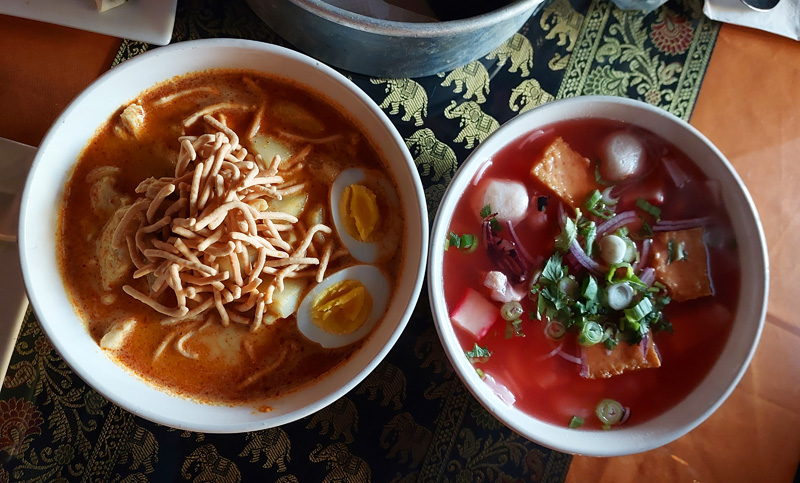PHOTOGRAPHS BY MACY TRAN / ILLUSTRATIONS BY WACSO (FILE) / HEAVY TABLE
This story originally appeared in the May 26, 2023 edition of the Tap newsletter. Back the Heavy Table on Patreon to get the Tap, Churn, Tulip and Schooner, and Hearth newsletters every Friday.
The curries, stir-fried noodles, and spicy salads of Thailand are prolifically available across the Minneapolis-St. Paul metro. However, after living four years in Thailand, my eyes glaze over when I open a menu at a Thai restaurant and I see the same, Midwest “Thai” dishes at every restaurant– red/green/massaman curry, papaya salad, pad thai, pad see ew, and even pho. Locally made Thai food is largely adapted to appeal to a Minnesotan palate. The pungent, fishy salads are tamed, the curries run sweet and creamy, and the heat of spicy stir-fries and soups is extinguished.
I couldn’t give up. I craved the unapologetic sour, spicy, and pungent flavors that lead to wiping sweat from my brow, blowing my nose, and puckering my face. I am determined to find Thai food that teleports me back to sitting at a steaming street-side restaurant with chili smoke from the wok making my eyes water and the citrusy smells of cilantro, lime, and lemongrass brightening my senses. Leave your pad Thai at the door – this is a culinary experience for those seeking to get out of their comfort zone, try new flavors, and learn about Thai people and culture along the way.

THAI CAFE | 371 University Avenue West, St. Paul
With just a few tables and a modest menu, Thai Cafe feels unassuming and humble. I settled on ordering Tom Saab, Sukiyaki Heng, and Naem– dishes with strong flavors that I loved eating in Thailand but didn’t often see on Minnesotan Thai menus. Tom Saab ($16) is similar to tom yum soup, except that it hails from northeastern Thailand where flavors tend to be super sour and extra spicy. This is characteristic of northeastern food, which many people claim as the spiciest food region of Thailand.
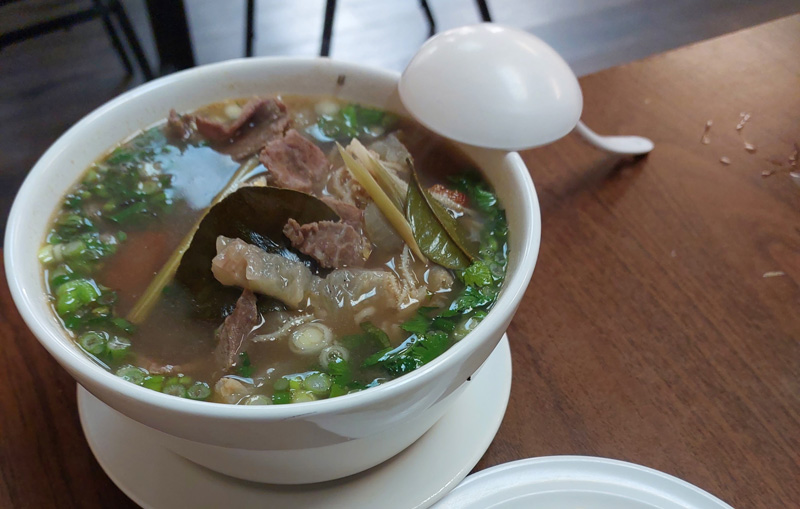
It is a clear broth soup with similar herbal elements (galangal root, lime leaf, and lemongrass) to tom yum. Instead of the usual shrimp in tom yum, tom saab traditionally uses pork ribs or tender beef. Thai Cafe’s tom saab included a hefty amount of beef tendon, tripe, and slices of steak, giving it balanced texture with the creamy fat of the tendon complimenting the chewiness of the tripe. The beef broth was decently sour, but it was quite mild on the spice-scale. If you’re looking for Thai level spice, I’d ask for fresh chili on the side to add to your soup.
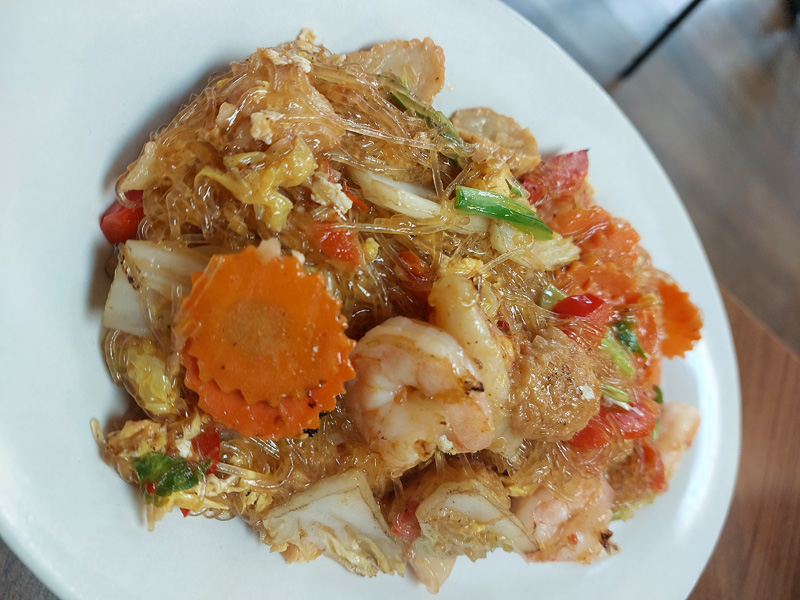
Thai Sukiyaki ($15) evolved from Japanese hotpot, but made to better appeal to the Thai palate with a sweet, spicy sauce. It consists of glass noodles, egg, napa cabbage, and a protein or any other vegetables of your choosing. Sukiyaki (also called suki for short) is a common street food and can be made in three ways: communal hot pot style, a clear-broth noodle soup served in individually portioned bowls, or stir fried. I always prefer to eat my suki stir fried because I particularly love the smokiness and soft and bouncy texture of glass noodles stir fried on a wok. Suki ingredients are quite simple, which is why suki sauce is so important to imparting impactful flavor. Thai Cafe’s suki sauce definitely delivered. The sauce perfectly balanced sweet, sour, and umami and partnered with the wok to make truly smoky noodles that weren’t left too wet, or too dry. Suki is not a particularly spicy dish, and usually comes quite mild– but I did appreciate how Thai Cafe’s suki sauce had a little kick at the end of a bite.
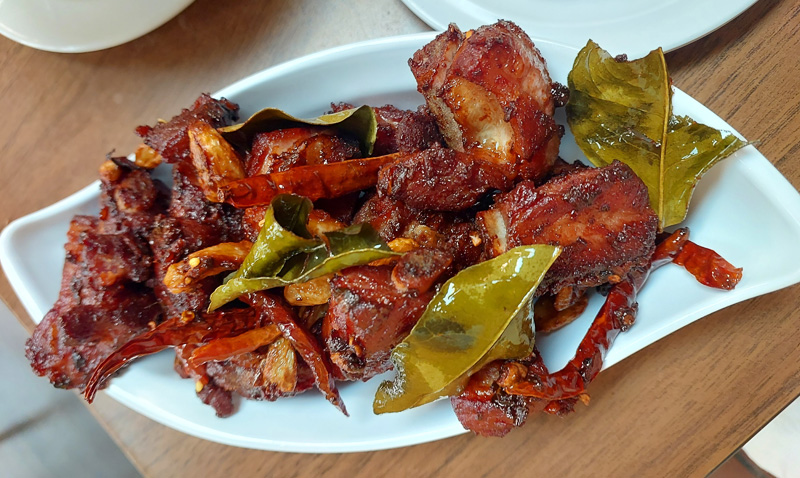
Naem is a fermented pork that exists across Southeast Asian cuisine. It is slightly sour and pungent in aroma and flavor. For those unfamiliar, it can come across a bit “funky”. But if you’ve never tried fermented pork before, Thai Cafe’s Stir Fried Pork Rib Naem ($20) is a great place to start. The caramelization on the outside of the ribs gives a nice crisp that compliments the fattiness of the pork. It is stir fried in a smoky medley of lime leaves, garlic, and dried chili, giving the ribs warmth and depth, which allows the distinct sourness of the pork to really stand out and have its moment, rather than being masked by spices and seasonings.
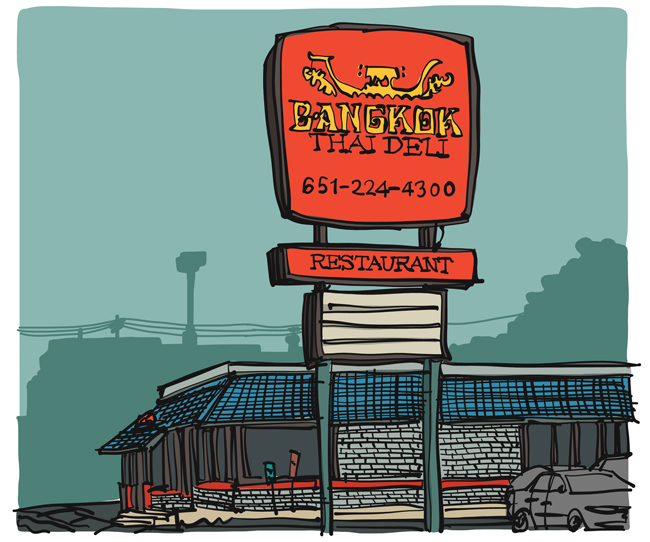
BANGKOK THAI DELI | 333 University Avenue West, St. Paul
Bangkok Thai Deli, one of the metro’s better-known Thai restaurants, was bustling during a recent lunch time rush. Instead of an American salt and pepper shaker on the table, Thais will always generally have dried chili flakes, vinegar, sugar, and fish sauce held in a caddy called kruang brung. When I walked into Bangkok Thai Deli and saw the kruang brung on every table, I felt at ease. Like your noodles more acidic? Add a spoon or two of vinegar. Want your soup more salty? Dash a few splashes of fish sauce. Bangkok Thai Deli boasts an extensive and diverse menu, offering a huge variety of street food, Thai classics, and regional specialities. There are plenty of options to explore; you could try a new dish every time you go. I decided to order Sai Krok Isan, Bamee Bed, and Khao Kha Moo.
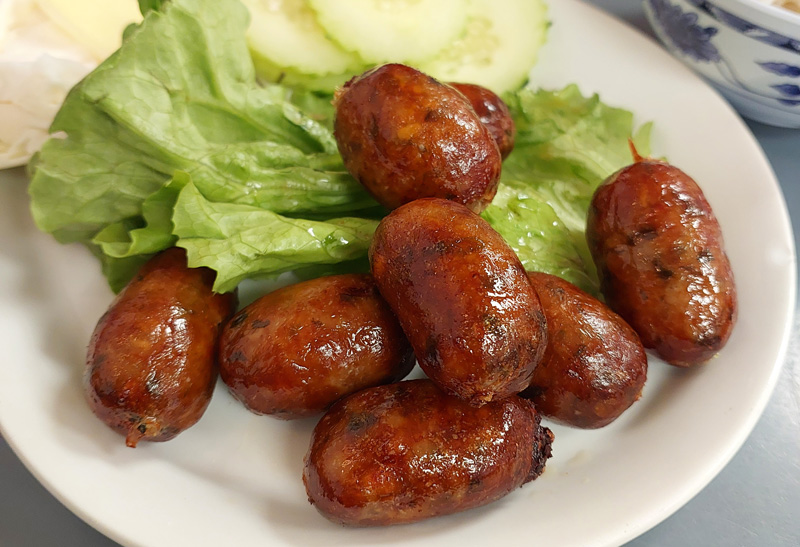
Sai Krok Isan, or Isan sausage, is a well-loved street food with origins in the eastern region of Thailand. I could never resist the porky, savory smoke rising from the hot grill whenever I passed by a sausage vendor’s cart. It’s usually eaten with sticky rice and raw cabbage or lettuce leaves. Bangkok Thai Deli’s pork sausage ($11) was lightly fermented, giving the distinctive, tangy naem aroma. The sausage was stuffed with rice and fragrant herbs and spices such as lemongrass, lime leaf, and chili which lended aromatic depth while helping to retain the moisture of the pork fat. This created a juicy sausage with a smoky grilled casing. Wrap it in the accompanying cabbage to balance the grease.

A classic dish eaten across southeast and east Asia, bamee, or egg noodles, play a versatile role in Thai cuisine. Eat them with a broth, or dry. Choose your protein toppings (usually pork, steamed wonton, and/or duck). When your bowl of steaming noodles arrives, you then dress your bamee how you prefer to eat them. I chose to order my Bangkok Thai Deli Bamee ($15) with dry egg noodles and with duck as the protein. I seasoned it with vinegar, chili flakes, and fish sauce to my taste. The quality of the protein can make or break the overall eating experience of the egg noodles, and I was extremely pleased at the succulence of the Bangkok Thai Deli duck meat. The duck was delicious and fatty, coating the noodles and operating as a flavor medium for the condiments. The bamee noodles themselves were perfectly cooked; egg noodles should have a little bite to them. Tossed in crushed peanuts, the noodles had a noticeable nuttiness, adding both aromatic nuance and texture to the dish.
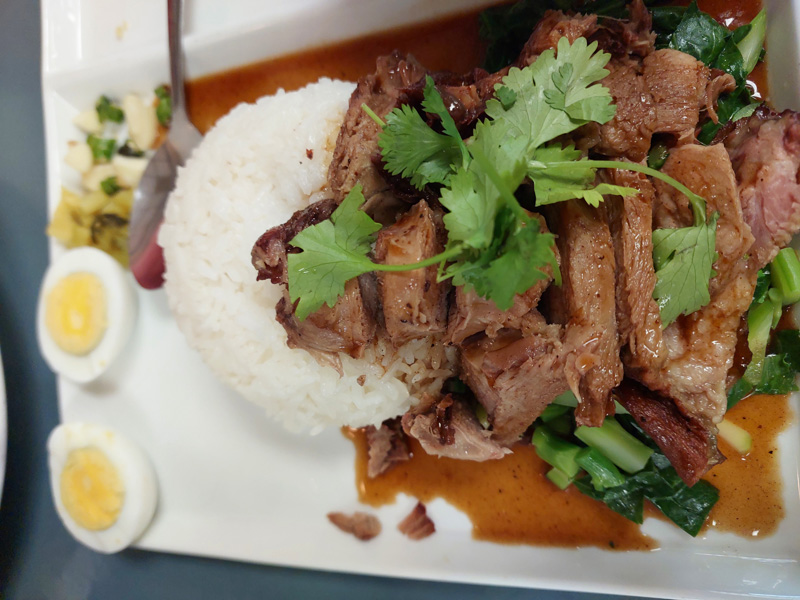
I was excited to see one of my favorite Thai dishes on the menu, Khao Kha Moo, or five-spiced slow-braised pork leg over rice. This dish is characterized by its tenderness from being slow cooked in its fatty, slightly sweet braising liquid spiced with cinnamon, star anise, and peppercorn. It’s served with a side of steamed chinese broccoli and pickled mustard greens to brighten and balance the warm flavors. The pork leg rice at Bangkok Thai Deli ($14) came with a hearty portion of super tender, melt-in-your-mouth pork and an even heartier portion of rice. But it felt a bit too sweet for my taste, and there wasn’t enough pickled mustard greens to elevate the acidity, so I added a bit of vinegar to balance it out. Because of the amount of rice served with this dish, I would have liked more braising liquid poured on top so that the entire dish remained moist throughout. Overall, the pork really shined for me, and should be the star of any khao kha moo.
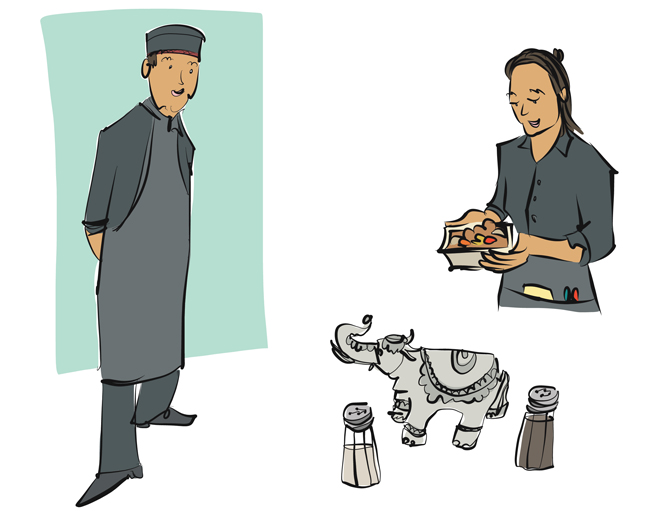
THAI GARDEN | 432 University Avenue West, St. Paul
Much like Thai Cafe, Thai Garden has only a handful of tables and an intimate atmosphere. The Thai pop music playing in the background and the cultural decor made me feel at home. Here, I ordered a few things on the menu I hadn’t tried at other places– Yen Ta Fo, Khao Soi, and Kaeng Chu Chee.
The family that runs Thai Garden hails from the northern city of Chiang Mai, the second-most populous city in Thailand. Khao soi is a regional specialty of the north, and although other restaurants also had khao soi, I definitely wanted to try the Khao Soi at Thai Garden ($15) because of the restaurant’s northern ties. Khao soi is a rich, creamy curry eaten with wide egg noodles, your choice of protein (usually stewed chicken or beef), topped with crispy fried egg noodles. It’s served with raw shallots and pickled mustard greens on the side, which are tossed into the bowl and finished with a squeeze of lime juice. The most important part of khao soi is the curry broth– and Thai Garden’s khao soi broth impressed me. It wasn’t too sweet, nor too creamy and diluted with coconut milk. It packed a lot of fishy, umami flavor characteristic of Thai curries, and a moderate amount of spice that added depth without being overbearing. If you go to a Thai restaurant and they serve lemon wedges with their food, this is a Minnesotan adaptation to Thai food that entirely changes the flavors of the dish. I highly recommend asking for lime, which is more tart and less sweet than lemon, and a crucial ingredient to Thai food that cannot be replaced by lemon. Khao soi is no different, and I am grateful Thai Garden served lime wedges to squeeze on top of the curry to counterbalance the salt and spice from the broth. Thai Garden certainly had the foundation down, but from there, it takes on more American-style fusion. Instead of dense egg noodles, Thai Garden served their khao soi with medium-wide rice noodles which I thought served as a “good-enough” starch medium for the curry, but didn’t deliver the bite that I quite wanted it to. Rather than the traditional stewed chicken drumstick, this version of khao soi used sliced white chicken breast, which, luckily, was still tender, but not as juicy as the bone-in chicken leg I was accustomed to. The server told me that usually the khao soi is served with pickled mustard greens that are fermented in-house, but on the day that I went they were currently in the pickling process and not yet ready to be served. Overall, I didn’t have high hopes of finding a spectacular version of khao soi in Minnesota given that it’s quite difficult to make, but I’d definitely order it again from Thai Garden.
Yen Ta Fo is another noodle soup dish, made with a clear broth and served with rice noodles. Its broth is known for its pink hue, acquired via fermented red bean curd. In addition to adding color, the bean curd gives the broth a tangy, floral taste. I particularly loved the bright tartness of the broth of Thai Garden’s Yen Ta Fo ($16), and the wide rice noodles they chose to accompany it. I also appreciated the variety and amount of seafood toppings (fishballs, squid, clam, octopus, imitation crab) which made it interesting and filling to eat. I am used to my yen ta go being spicy, and this version came out mild– I asked for extra chili to add to my soup as well as a bit of sugar and fish sauce to adapt it more to my taste.
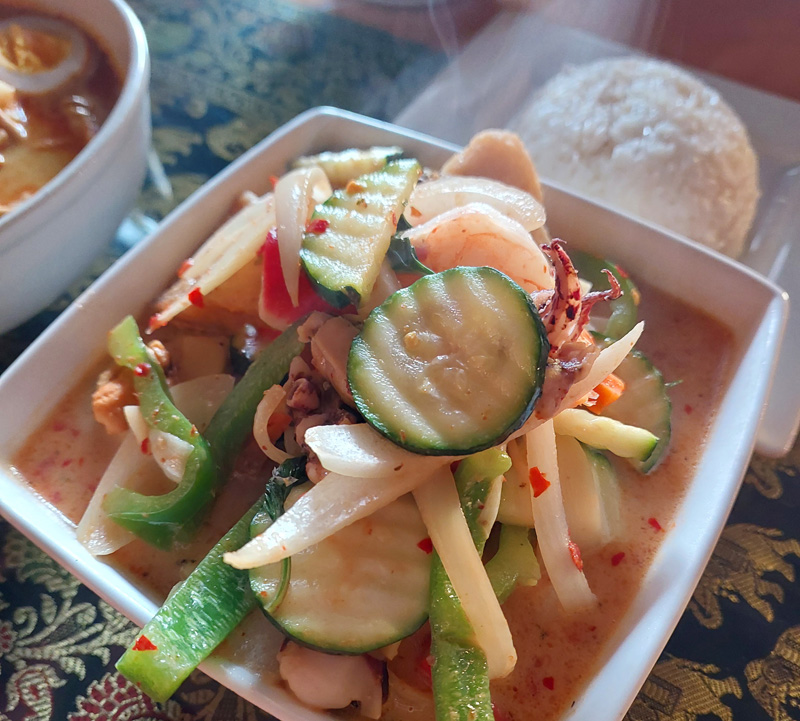
Kaeng chu chee, or chu chee curry, is a spin on a traditional red curry. It’s usually made with fried fish as the main protein, and has thicker consistency than a normal red curry. Chu chee has a particularly piquant fishiness from the protein as well as the amount of shrimp paste used compared to other curries. It is also a tad sweeter and has a strong coconut aroma. Anticipating the spice-level to be on a Minnesota scale, I asked for the highest level. I was not prepared for the heat that came my way via Thai Garden’s Kaeng Chu Chee ($19), but thoroughly enjoyed sweating through it. The server mentioned after the fact that the spice scale was according to Thai tastes, and that they use fresh, crushed Thai chili instead of dried chili flakes, making the heat more intense. I assured the server that despite my sniffling and sweating, I really appreciated the curry’s heat, which was the first time I encountered that level of spice in Minnesota. None of the other restaurants I went to delivered spice quite like Thai Garden did. The curry paste was rich and sweet enough to feel like chu chee, but not overbearingly sugary. The fish was soft and flaky, and there was a diverse mix of vegetables and seafood.
THE FLAVOR JOURNEY CONTINUES
I started this Thai food crawl to explore what the Twin Cities has to offer beyond the basic, mainstream Thai–Minnesotan staples. And although no place perfectly captured the Thai flavors and experiences I was seeking, they all captured the essence of Asian-American cooking–making do with what you have, and deliciously crafting a culinary home with it. I still successfully found many of the familiar juicy, sour, smoky, and spicy tastes, textures, and aromas of Thailand, right in St. Paul.
The real gift is that instead of finalizing any definitive conclusions or judgments about the Thai foodscape in the Twin Cities, I found myself infinitely more curious about the other menu items I didn’t try, and other Thai eateries sprinkled throughout the cities I have yet to explore. This article is by no means a comprehensive review of the diversity of Thai food in Minnesota, but my hope is that it will inspire you to order something new, ask questions, and challenge yourself. On May 27 and 28, the Minnesotan-Thai diaspora will celebrate Songkran, the Thai new year and water festival, at the State Capitol. Thai food, ritual, music, and dance will be celebrated and shared with the public. This will be a great opportunity to learn about and taste even more Thai food, in concert with Thai culture and community. Equipped and empowered with an open mind and stomach, here’s to a new year of broadening your palate, exploring dishes you never thought you’d never try, and encouraging others to do the same. สวัสดีปีใหม่ ! Sawadee bpee mai! Happy New Year!

